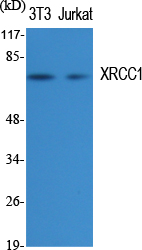XRCC1 Polyclonal Antibody
- SPECIFICATION
- CITATIONS
- PROTOCOLS
- BACKGROUND

Application
| WB, IHC-P |
|---|---|
| Primary Accession | P18887 |
| Reactivity | Human, Mouse, Rat |
| Host | Rabbit |
| Clonality | Polyclonal |
| Calculated MW | 69498 Da |
| Gene ID | 7515 |
|---|---|
| Other Names | XRCC1; DNA repair protein XRCC1; X-ray repair cross-complementing protein 1 |
| Dilution | WB~~Western Blot: 1/500 - 1/2000. Immunohistochemistry: 1/100 - 1/300. ELISA: 1/10000. Not yet tested in other applications. |
| Format | Liquid in PBS containing 50% glycerol, 0.5% BSA and 0.09% (W/V) sodium azide. |
| Storage Conditions | -20℃ |
| Name | XRCC1 {ECO:0000303|PubMed:2247054, ECO:0000312|HGNC:HGNC:12828} |
|---|---|
| Function | Scaffold protein involved in DNA single-strand break repair by mediating the assembly of DNA break repair protein complexes (PubMed:11163244, PubMed:28002403). Negatively regulates ADP- ribosyltransferase activity of PARP1 during base-excision repair in order to prevent excessive PARP1 activity (PubMed:28002403, PubMed:34102106, PubMed:34811483). Recognizes and binds poly-ADP-ribose chains: specifically binds auto-poly-ADP-ribosylated PARP1, limiting its activity (PubMed:14500814, PubMed:34102106, PubMed:34811483). |
| Cellular Location | Nucleus. Chromosome Note=Moves from the nucleoli to the global nuclear chromatin upon DNA damage (PubMed:28002403). Recruited to DNA damage sites fowwing interaction with poly-ADP-ribose chains (PubMed:14500814) |
| Tissue Location | Expressed in fibroblasts, retinal pigmented epithelial cells and lymphoblastoid cells (at protein level) |

Thousands of laboratories across the world have published research that depended on the performance of antibodies from Abcepta to advance their research. Check out links to articles that cite our products in major peer-reviewed journals, organized by research category.
info@abcepta.com, and receive a free "I Love Antibodies" mug.
Provided below are standard protocols that you may find useful for product applications.
Background
Involved in DNA single-strand break repair by mediating the assembly of DNA break repair protein complexes. Probably during DNA repair, negatively regulates ADP-ribose levels by modulating ADP-ribosyltransferase PARP1 activity.
If you have used an Abcepta product and would like to share how it has performed, please click on the "Submit Review" button and provide the requested information. Our staff will examine and post your review and contact you if needed.
If you have any additional inquiries please email technical services at tech@abcepta.com.













 Foundational characteristics of cancer include proliferation, angiogenesis, migration, evasion of apoptosis, and cellular immortality. Find key markers for these cellular processes and antibodies to detect them.
Foundational characteristics of cancer include proliferation, angiogenesis, migration, evasion of apoptosis, and cellular immortality. Find key markers for these cellular processes and antibodies to detect them. The SUMOplot™ Analysis Program predicts and scores sumoylation sites in your protein. SUMOylation is a post-translational modification involved in various cellular processes, such as nuclear-cytosolic transport, transcriptional regulation, apoptosis, protein stability, response to stress, and progression through the cell cycle.
The SUMOplot™ Analysis Program predicts and scores sumoylation sites in your protein. SUMOylation is a post-translational modification involved in various cellular processes, such as nuclear-cytosolic transport, transcriptional regulation, apoptosis, protein stability, response to stress, and progression through the cell cycle. The Autophagy Receptor Motif Plotter predicts and scores autophagy receptor binding sites in your protein. Identifying proteins connected to this pathway is critical to understanding the role of autophagy in physiological as well as pathological processes such as development, differentiation, neurodegenerative diseases, stress, infection, and cancer.
The Autophagy Receptor Motif Plotter predicts and scores autophagy receptor binding sites in your protein. Identifying proteins connected to this pathway is critical to understanding the role of autophagy in physiological as well as pathological processes such as development, differentiation, neurodegenerative diseases, stress, infection, and cancer.


